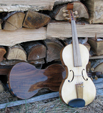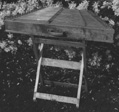|
|
 |
Violin
I studied violin making and acoustics with
Carleen Hutchins, a student of Simone
Sacconi, and a founder of the Catgut Acoustical Society.
This is a Strad pattern instrument, in red
spruce and birdseye maple.
|
 |
Baroque Violin
A small violin on an Amati pattern of 1653,
set up as a Baroque instrument.
|
 |
Viola
A 16-1/4" (413 mm) viola, in Englemann
spruce and Broadleaf maple.
|
 |
5-string “Folk Viola”
A violin and viola all rolled into one, with
a simplified design that allows it to retain all of the traditional
sound while taking only half as long to build. Available in 16-3/4"
(425.5mm) and 16-1/4" (413mm) body lengths. Note that the
string length is somewhat shorter than that of a “normal”
viola of the given size, to accommodate the high E string. This
instrument has a custom head instead
of the “shield volute” normally used on this model.
|
 |
The 5-string fiddles are still in demand. I keep making them a little shorter, and with this design the corners really became necessary. These two use guitar style binding, with no overhang. |
 |
On more recent 5 strings I've gone to making the overhang, with inlaid purfling. This one also has a scroll rather than a shield volute, at the customer's request. Here's a shot of the cherry back of the same instrument. |
 |
Harps
The first time I heard Alan Stivell's “Renascence
of the Celtic Harp” I had to make that sound somehow, so
I did it my way, by learning to make harps. My harps are based
on the “Brian Boru” and “Queen Mary” harps,
but use “modern” glued-up construction rather than hollowed-out
bodies. Most are rectangular, although a semi-stave back is available
as an option. As on the originals I use a removable closure for
the back, and have soundholes in the front for better projection.
The soundboards are cross-grained solid spruce, double tapered
for a clear, open tone. All joints are hand-fitted mortise and
tenons. The two-headed salmon carving is standard, and custom
carving can be done.
Body woods: walnut, cherry, mahogany or maple standard
25 string - wire or nylon. $900
31 string - wire or nylon. $1800
|
 |
Mountain Dulcimers
The mountain dulcimer was the instrument that
got me hooked on building, and I still like to make them. Most
of the ones I make these days use machine tuners, but these older
pictures show friction pegs with bead-type fine tuners, which
work well.
Basic model - $175
Intermediate model - $250
Professional model - $375
“Ozark” model - $525
The dulcimer on the left is an “Intermediate”
model, in walnut and redwood, with a rubbed oil finish. The “Basic”
model is similar, but uses a somewhat simplified head and guitar-style
machines. The “Professional” model features a more elaborate
carved head, violin-style inlay purfling around the edge of the
top, and a varnish finish. The instrument on the right in the
photo is in the “Ozark” style, in curly cherry and spruce.
|
 |
Hammered dulcimers
Standard - 4' length - major keys are G, C
and D. $700 Includes a folding stand.
Student - 3' length - major keys; C, F and
G. $500 Also available with extra courses, including chromatics,
and custom stringing. Inquire.
It's hard not to love the sound of the hammered
dulcimer, either for dancing or as an instrument in it's own right.
My standard design features 12 treble and 11 bass courses. The
deep body gives the instrument a lot of stability in tuning, and
a sweet sound that is augmented by the triple-stringing that I
normally use. I use all solid woods; cherry, walnut and mahogany
being the most common body woods, with spruce or redwood for the
soundboard. By the way, in my design, the soundboard is on the
bottom!
The instrument shown is an 18/17 in butternut
wood.
Back to top
|
|

